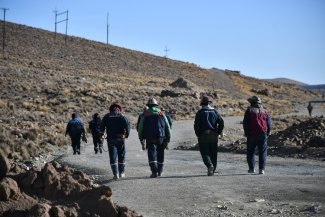
In this April 2019 photo, care professionals and nursing students at Tampere University in Finland participate in an experiment on the use of exoskeleton vests in care settings.
Imagine you’re on a car production line. Hundreds of times per day you bend over, sit on your knees or lift a drill, that weighs 20 kilos, above your head. Or maybe you’re a nurse, who needs to lift patients from wheelchairs over and over again. As you might imagine, these are environments that easily produce injuries. In 2017 there were around 900,000 workplace injuries in the European Union due to “dislocations, sprains and strains”. In the United States “sprains, strains and tears” were the most common workplace injuries in 2018, accounting for 34 per cent of the total, or 308,630 injuries.
At-risk workers may soon be getting some help in the form of exoskeletons, or wearable, mechanical structures that enhance the physical ability of a person. Where robots are entities separate from the human body, exoskeletons are machines we attach to ourselves to physically assist our actions.
These suits might sound like something straight out of a science-fiction movie and yet experiments with them are becoming more popular. Large industrial companies like Ford, Boeing, Toyota and BMW are all equipping their workers with variations of these suits. In Japan researchers experimented with exoskeletons to help ageing farmers do their work. And in Finland, Tampere University is testing the use of exoskeleton vests on geriatric nurses.
The goal here isn’t to give workers superhuman strength, but to reduce the workplace strains and injuries suffered by workers who have to do repetitive actions all day long.
“Engineers are innovating quickly to develop new technologies,” says Jean Theurel, a researcher and head of the exoskeletons programme at the French National Research Institute for Occupational Health and Safety (INRS). “These projects are very valuable. Exoskeletons intend to reduce workplace injury by enhancing, rather than replacing the human worker.”
Helping workers, not making superhumans
Today there are two main types of industrial exoskeletons: active and passive devices. Active exoskeletons create support with the help of a power input like a battery. Passive exoskeletons, which are the most common today, don’t use batteries, and offer support through methods like springs.
“We don’t want to make people work faster or harder,” says Sander De Bock, a PhD student at the Free University of Brussels, where he researches industrial exoskeletons. “We want to reduce absenteeism by having exoskeletons reduce long-term strain and improve comfort at work.”
This reality counters the image of exoskeletons handed down from science-fiction. In movies like Elysium or Edge of Tomorrow, actors such as Matt Damon and Tom Cruise use exoskeletons to become fighters with superhuman strength. But that’s not the goal for De Bock. “We don’t want to make workers stronger, or have them take less breaks,” he says. “The idea is not to make people lift massive weights. We want to offer the subtle support that makes the difference between too much strain, and a normal amount of exercise.”
Nevertheless there’s still uncertainty around exoskeletons. Companies are experimenting with them, but the jury is still out on their efficacy. Theurel mentions that because of the relatively recent introduction of exoskeletons, “the current state of knowledge does not support an unreserved endorsement for using these technologies.”
There is also the possibility that these devices could cause injuries of their own. Theurel tells Equal Times: “Previous studies revealed unwanted consequences of using exoskeletons during handling tasks, such as postural strains and balance regulation.” He also adds that there are still some areas where the long-term effects of these devices are unclear, for example on joint health. There is even a risk of skin irritation or even collision with objects or people around the worker, since the exoskeleton increases their size, to which they may not be accustomed.
And then there is the issue of how exoskeletons will enter the workplace. Researchers might have good intentions, but ultimately, it is up to management how this wearable technology will be used. “We know from the perpetual struggle to get lifting aids in hospitals that improving worker health, safety and job satisfaction may not be high on the list of management priorities,” says Rory O’Neill, editor-in-chief of Hazards magazine, a magazine focusing on workplace safety, referring to they way in which nurses and healthcare assistance often struggle to get enough devices to help with lifting patients.
O’Neill argues that before introducing exoskeletons, there needs to be more commitment to job redesign, to reduce strain on workers, and putting an end to practices like tying wages and bonuses to the pace of work. He also warns that some bosses may still be tempted to increase work-speeds with the use of exoskeletons. One historical example of this is the Davy Lamp, a 19th century safety lamp for miners, which was supposedly introduced to improve safety, but which actually served to increase production as it allowed miners to access deeper seams of coal. “It is worth remembering that throughout history, safety solutions imposed by management, have turned out to be motivated primarily by a desire to increase production,” O’Neill warns.
Workers’ input
Despite these considerations, researchers such as Theurel are hopeful about the potential of the technology. At the same time including workers in the roll-out of exoskeletons is likely to be key to their success. This is something that Shirley Elprama, a senior researcher in the Studies on Media, Information and Telecommunication department (imec-SMIT) at the Free University of Brussels, is looking into. “I study the acceptance of exoskeletons in workplaces,” she says. “I look at why people want or don’t want to use these technologies in their work.”
She conducts interviews and surveys with workers that already use exoskeletons. “You need to pay attention to the human,” says Elprama. “Every workplace technology needs to look at the context in which it’s implemented. You cannot simply drop the technology on workers. There needs to be context and input from those who will use it.”
Unions can play a big role here. “Unions need to think clearly about the problems their management want exoskeletons to solve,” says O’Neill. “If it is genuinely improving working conditions, are there other, better solutions? And if it is reducing labour costs and productivity, unions have to ask who will really be paying the price.”
Participation might also be useful in making exoskeletons more women-friendly. De Bock notes that women’s and men’s bodies are different, which some exoskeletons don’t handle well. Some commercial versions offer their support in the breast area, which makes these exoskeletons harder for women to wear. De Bock even mentions how in some cases they move their pressure up when worn by women, and push against the neck.
“The technology is still in its early stages, and some companies focus on the largest group of industrial workers doing heavy work, which are in a lot of cases men,” says De Bock. “Nevertheless more attention is currently going to women-friendly designs.”
This is a problem that is also recognised by Theurel. “Women-specific exoskeleton technologies haven’t received the attention they deserve,” he says. Adding that: “The effectiveness of exoskeletons in the workplace depends on a complex interaction between the specificities of the exoskeleton, the specificities of the task, and the specificities of the worker.”
Partly because of hiccups like this, exoskeletons remain an early-stage technology and we might have to wait some years before a full market introduction will be feasible. “Some companies aren’t convinced exoskeletons are fully mature yet,” says Elprama. “They aren’t always comfortable enough. And sometimes the exoskeleton doesn’t support all the movements the worker needs to make, which might even limit their freedom.”
De Bock projects the arrival of these devices over the next five to ten years, with passive exoskeletons leading the way and their active counterparts moving slower. Nevertheless, the input of workers will be crucial if this technology is going to take off. “It’s crucial that they want to use this technology,” says the researcher. “We need to include them in the process, so they can express their concerns and have a dialogue with the people that are designing exoskeletons.”









